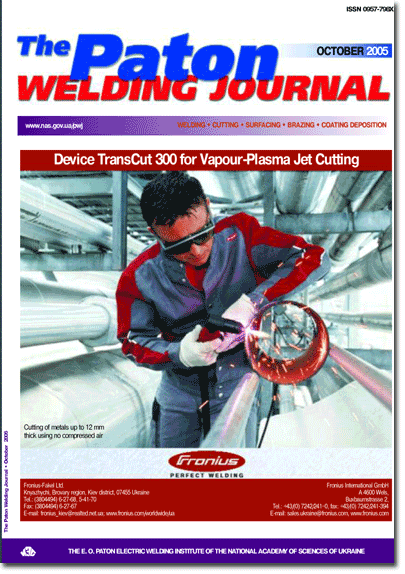

| SCIENTIFIC AND TECHNICAL | |
| Labur T.M., Ishchenko A.Ya., Taranova T.G., Kostin V.A. and Grigorenko G.M. Nature and features of microdeformation in the zone of crack initiation and propagation in high-strength aluminuim alloy D16AT | 2 |
| Features of microdeformation of individual structural components within the zone of crack initiation and propagation in a high-strength aluminum alloy have been studied. Characteristics of crack initiation and propagation have been determined. It is shown that a proportional relationship exists between the conditions of microdeformation of metal internal structure caused by initial stresses and the resistance to crack propagation. | |
| Tsybulkin G.A. Influence of frequency properties of the welding circuit on current parameters in pulsed-arc welding processes | 9 |
| Results of analysis and modeling of frequency characteristics of welding circuit in pulsed-arc welding processes are given. Three different approaches to implementation of these processes are considered, namely through modulation of output voltage of the welding current source, exciting torch vibrations, and pulsed feed of electrode wire. It is shown that the working range of welding current pulses strongly depends on the approach employed. | |
| Margolin B.Z., Varovin A.Ya. and Kostylyov V.I. Determination of residual stresses in the WWER vessels after multi-run welding, surfacing and high-temperature tempering | 14 |
| Calculations of residual stresses formed after welding, surfacing and tempering have been made for bodies of the water-moderated (WWER) type reactors. The calculation procedure is based on solutions of temperature and non-isothermal elastoplastic problems obtained using the finite elements method. a-Fe Л g-Fe transformations and creep have been allowed for in solving the deformation problem. The investigations conducted show that the a-Fe Л g-Fe ransformation does have an effect on the distribution of residual stresses depending upon the conditions, under which this effect can be substantial, and under which it can be ignored. | |
| Brodovoj A.V., Brodovoj V.A., Gushcha O.I. and Bunchuk S.G. Effect of reducing residual stresses in welded joints of aluminium alloy D16 by magnetic field treatment | 21 |
| The effect of exposure to non-uniform magnetic field on residual welding stresses in specimens of aluminium alloy D16 has been studied. It is shown that a long exposure of specimens containing a weld leads to a substantial decrease in the value of residual stresses. Suggested is an explanation to the observed effect. | |
| Pentegov I.V. and Petrienko O.I. Method of determination of wire temperature at nozzle outlet in gas-shielded mechanized welding | 23 |
| The paper presents the method for calculation of wire temperature, when it goes out of the nozzle, allowing for voltage drop in the point of electrode wire contact with the welding torch nozzle. Theoretical-calculation analysis results are in good agreement with experimental data. | |
| INDUSTRIAL | |
| Kovtunenko V.A., Sineok A.G., Gerasimenko A.M. and Zadorozhny V.A. Typical damages of welded metal structures of bridges | 27 |
| Analysis results are presented on characteristic damages of weldments and welded joints in metal structures of active bridge spans in Kiev. Main factors affecting formation and propagation of the above damages are given. The top priority measures aimed at improvement of operational safety of bridges are recommended. | |
| Khorunov V.F. and Maksymova S.V. Amorphous filler alloysЕ promising material for advanced brazing processes (Review) | 33 |
| Different methods for production of alloys in the amorphous and nanocrystalline states are considered. It is shown that the main advantage of amorphous brazing filler alloys is that they are produced in the form of thin ductile foils, which can be used as inserted elements of any shape to fabricate unique structures, primarily for aerospace and nuclear power engineering. High chemical homogeneity of amorphous brazing alloys and their narrow melting point ranges provide good wetting of the surface treated, and reduction of the probability of formation of lacks of penetration and brittle phases, thus ensuring high strength of the brazed joints. | |
| Tsaryuk A.K., Skulsky V.Yu., Volkov V.V., Byvalkevich A.I., Podiachev V.V., Ivanov N.A., Nemlej N.V., Miroshnichenko A.P. and Bazhukov A.V. To the problem of selection of the technology for welding elements of MCP Dn850 in replacement of steam generators PGV-1000M at NPP | 39 |
| It is recommended to use the tested and certified method of automatic argon-arc welding with 0.8Д0.9 mm filler wire, instead of manual welding, to produce sound joints between elements of the main circulation piping and steam generator branch pipes. The suggested process allows reduction in labour consumption and welding operation cycle, provides high and consistent quality of welded joints, and makes it possible to decrease dose of the radiation effect on personnel performing welding operations. | |
| Shelyagin V.D., Khaskin V.Yu., Shitova L.G., Nabok T.N., Siora A.V., Bernatsky A.V. and Chizhskaya T.G. Multi-pass welding of heavy steel sections using laser radiation | 46 |
| Technology of automated multi-pass laser and laser-arc welding of structural steels with thickness of up to 20 mm is described. Productivity of the hybrid welding method is several times higher compared with laser welding. | |
| Levchenko O.G. and Chigarev V.V. Calculation of productivity of local exhaust ventilation for conditions of the flux-cored strip surfacing | 50 |
| Peculiarities of selection of optimal parameters for local exhaust ventilation, allowing for the air velocity within the arc zone and amount of the removed air, are considered in terms of improvement of the efficiency of entrapping harmful materials from the flux-cored strip surfacing zone. | |
| BRIEF INFORMATION | |
| Kisilevsky F.N. , Shapovalov E.V. and Melnik E.S. Monitoring system for a pipe-welding mill | 53 |
| Welding process monitoring and control system for a pipe welding mill has been developed. The system consists of three subsystems, namely for control of penetration from the reverse side of the weld pool, control of the pipe weld formation and weld following. Design of these subsystems using a technical vision system, as well as hardware and algorithmic methods for minimizing the effect of optical (blinks and flashes due to the welding arc) and mechanical (scratches, rust, burrs) interferences, are considered. The system provides high real-time measurement accuracy. | |
| Kuskov Yu.M., Lebedev V.A., Ryabtsev I.A., Poddubsky A.I. and Shapran R.V. Reconditioning of large-sized parts for equipment of ore mining and processing complexes by the mechanized arc surfacing | 56 |
| Methods for reconditioning of large-size parts of mining equipment by mechanised arc surfacing are considered. The possibility of an efficient application of semi-automatic surfacing using self-shielding flux-cored wires for the above purposes is shown by an example of treatment of a crushing cone shaft. | |
| NEWS | 59 |
| Developed at PWI | 13, 20, 38, 45, 52 |
(You are viewing the simplified file contents)
Sorry, the PDF of this issue is not yet available
The cost of subscription/purchase order journals or individual articles
| Journal/Currency | Annual Set | 1 issue printed |
1 issue |
one article |
| TPWJ/USD | 384 $ | 32 $ | 26 $ | 13 $ |
| TPWJ/EUR | 348 € | 29 € | 24 € | 12 € |
| TPWJ/UAH | 7200 UAH | 600 UAH | 600 UAH | 280 UAH |
| AS/UAH | 1800 UAH | 300 UAH | 300 UAH | 150 UAH |
| AS/USD | 192 $ | 32 $ | 26 $ | 13 $ |
| AS/EUR | 180 € | 30 € | 25 € | 12 € |
| SEM/UAH | 1200 UAH | 300 UAH | 300 UAH | 150 UAH |
| SEM/USD | 128 $ | 32 $ | 26 $ | 13 $ |
| SEM/EUR | 120 € | 30 € | 25 € | 12 € |
| TDNK/UAH | 1200 UAH | 300 UAH | 300 UAH | 150 UAH |
| TDNK/USD | 128 $ | 32 $ | 26 $ | 13 $ |
| TDNK/EUR | 120 € | 30 € | 25 € | 15 € |
AS = «Automatic Welding» - 6 issues per year;
TPWJ = «PATON WELDING JOURNAL» - 12 issues per year;
SEM = «Electrometallurgy Today» - 4 issues per year;
TDNK = «Technical Diagnostics and Non-Destructive Testing» - 4 issues per year.


